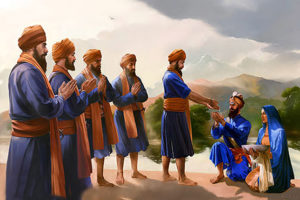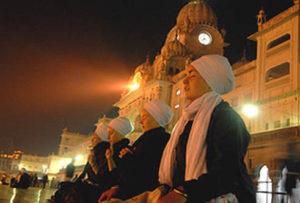Sikh code of conduct

The Sikh Rehat Maryada (Punjabi (Gurmukhi): ਸਿੱਖ ਰਹਿਤ ਮਰਯਾਦਾ, Sikkh Rahit Maryādā) (alternate transcription Sikh Reht Maryada is a code of conduct and conventions for Sikhism, approved by the Shiromani Gurdwara Parbandhak Committee, Amritsar in 1945. It is one of many Rahitnama (code of conducts) written for Sikhs.
The Rehat Maryada was created to standardise practical and functional aspects of the operations of Sikh Gurdwaras and religious practices to foster cohesion throughout the community. Before Sri Guru Gobind Singh Sahib Ji’s (the 10th Sikh Guru) joti jot (his soul merged with the one devine light) in 1708, he transferred his authority to the Sikh Holy Scripture, Guru Granth Sahib, and the body of initiated Sikhs, called the Khalsa Panth. However between 1708 and 1925 the Sikh community experienced sectarianism and no centralized authority apart from that arranged under British rule from 1849. A range of other codes and collections of tradition existed, but none represented the entire community (Panth).
In 1925, the Punjab Sikh Gurdwara Act (the Act) was introduced and legislated the establishment of the Shiromani Gurdwara Parbandhak Committee (SGPC) (an elected body of Sikhs) for the purpose of administering Gurdwaras.March 1927A general meeting of the SGPC was held on 15 March 1927, to establish a subcommittee with the task of producing a draft Code of Conduct. The subcommittee at the time consisted of 29 high-profile Sikhs, listed by name in the Introduction to the Sikh Rehat Maryada.October 1931 – January 1932A preliminary draft was circulated to Sikhs in April 1931, for comment.
The subcommittee met on 4 and 5 October 1931, 3 January 1932, and 31 January 1932, at the Akal Takht, Amritsar. During this time the number of subcommittee members present at meetings reduced, and other people were listed as present.March 1932On 1 March 1932, four members were exited from the subcommittee, and eight more were appointed. Of the four who were exited, one had died and another was excommunicated May and October 1932The subcommittee met again to deliberate and consider the draft on 8 May 1932 and 26 September 1932.
On 1 October 1932, the sub-committee submitted its report to the Secretary, SGPC, recommending a special session of the SGPC be convened to consider the final draft and approve it for acceptance.December 1933The SGPC arranged a conclave of Sikhs on 30 December 1933, where 170 individuals attended and debated the draft. Only nine attendees where members of the original sub-committee, and the conclave ultimately failed to reach an agreement.The SGPC then received comments on the draft from a subcommittee of 50 individuals and 21 Panthic Associations (including international organisations), all of whom are listed in the Introduction to the Sikh Rehat Maryada.August and October 1936After nearly three years, on 1 August 1936, the broader subcommittee approved the draft, and the general body of the SGPC ratified it on 12 October 1936.
Thereafter the Rehat was implemented.January and February 1945At their meeting on 7 January 1945 the SPGC’s Advisory Committee on Religious Matters recommended some changes to be made to the Code. The Advisory Committee consisted of eight individuals as listed in the Preface to the Sikh Rehat Maryada. The SGPC accepted the recommendations at their meeting on 3 February 1945.
Since then, several minor updates have been made to clarify content, but no significant review has been undertaken.
Principal points
The Sikh Rehat Maryada addresses key issues such as the definition of a Sikh, personal and communal obligations such as meditation and volunteer service, rules for Gurdwara services to include appropriate music and festivals, and the conduct of assorted Sikh ceremonies.
Definition of Sikh
A Sikh is defined as any person, male or female, who faithfully:
- believes in the existence of One Eternal God
- follows the teachings of, and accepts as their only Spiritual guides, the Guru Granth Sahib and the ten human Gurus
- believes in the baptism (Amrit Sanchar), as promoted by the tenth Guru
- does not owe allegiance to any other religion
Sikh living
There are two aspects to a Sikh living. One is the adherence to a personal discipline and the development of a strong family life. The other is the involvement in communal life and to ensure community well-being and infra-structure for support of the weak within the community local and globally. This is the practical aspect of the three pillars of Sikhism promoted by Guru Nanak called Wand kay Shako (share and consume).
Personal life
- Naam Japna – Meditation on God’s Name and the recital of the holy scriptures:
- To arise in the early hours and recite Gurbani in the morning (Five Banis), evening (Rehras) and night (Kirtan Sohila), collectively known as the Nitnem, followed each time with the Ardas prayer. To remember God at all times and to recite his name whenever possible. (Naam Simran)
- Seek only the support of the Almighty Lord before beginning any new task or venture. (Ardas)
- Kirat Karni – Leading one’s life in accordance with the Guru’s teachings:
- Engage in an honest profession or other work or course of study.
- Promote the family way of life giving time to children in an active way so as to ensure their proper awareness of the Sikh way of life.
- To live humbly and with love in an extended family group encouraging Gurmat principles and offering moral support within this extended structure.
- Seva – Undertake free voluntary service within the community at Gurdwaras, community projects, hospitals, old peoples homes, nurseries, etc.
- At every opportunity to spend ones free time to free community work and devote at least 10% of ones wealth in time or money to support community projects.
- To positively support weaker members within the community.
- Disciplined life – The Sikh is commanded by the Gurus to lead a disciplined life and to not follow blindly rituals and superstitions which bring no spiritual or material benefit to the person or community.
- Follow the teachings of the Sri Guru Granth Sahib
- Do not eat meat that has been slaughtered in a ritualistic way (Kutha meat) and refrain from using all forms of intoxicants. Alcohol and tobacco is strictly prohibited.
- Refrain from rituals, superstitions and other anti-Sikh behavior such as gambling, etc.
- Apart from one’s wife (or husband) to treat all females (or males) as daughters, sisters or mothers (sons, brothers or fathers) depending on their age.
- To practice and promote complete equality between the genders; castes; races, religions, etc.
Communal life
The Sikh has a duty to actively contribute to the community outside the family unit. Time needs to be given to the greater Sikh community and the even wider world community. It is the duty of the Sikh to hold a continuous dialogue with all members of the larger community, to treat them as equals, and respect their religions and their customs.
Meditating and scriptures
Sikhs engage in personal and communal meditation, Kirtan and the study of the holy Scriptures. Meditating and understanding of the Guru Granth Sahib is important to the development of a Sikh. One should not only study Gurmukh iand be able to read Gurbani but also understand the meaning of the text. Translations and other material may be used to assist the Sikh. The Sikh should revert to the Guru Granth Sahib for the all spiritual guidance in one’s life.
Congregation and scripture
It is believed that a Sikh is more easily and deeply affected by Gurbani when engaged in congregational gatherings. For this reason, it is necessary for a Sikh to visit Gurdwaras, the places where the Sikhs congregate for worship and prayer. On joining the holy congregation, Sikhs should take part and obtain benefit from the joint study of the holy scriptures.
No one is to be barred from entering a Gurdwara, no matter in which country, religion or caste he/she belongs to. The Gurdwara is open to all for the Guru’s darshan (seeing the holy Guru) and Langar. However the person must not have on his/her person anything, such as tobacco or other intoxicants, which are tabooed by the Sikh religion. Shoes must be removed, one’s head must be covered, and respectful clothing is a must.
Service in Gurdwaras
During a service in a Gurdwara and while congregational sessions are in session, only one activity should be done at a time in one hall in the presence of the Guru – performing of kirtan, delivering of discourse, interpretative elaboration of the scriptures or the reading of the scriptures.
Kirtan
Sikhs, though anyone with correct pronunciation and understanding of Gurbani who desires to take part in the congregation, perform Kirtan (Spiritual hymn singing) in a congregation and only hymns (Shabads) from the holy scriptural compositions in traditional musical measures should be sung. Only Shabads from Guru Granth Sahib Ji Gurbani and the compositions of Bhai Gurdas and Bhai Nand Lal, may be performed. It is improper to sing Kirtan to rhythmic folk tunes or popular film tunes.
Ardas and Guru’s Hukam
Before taking a Hukam from the Guru, an Ardas must be done where all the congregation would stand for the Ardas and then sit down and carefully listen to the Hukam of the Guru.
Akhand Paath and Sadharan Paath
Akhand Paath: Is the non-stop reading of the Guru Granth Sahib carried on during difficult times or during occasions of joy and celebration. The reading takes approximately forty eight hours of continuous and uninterrupted reading by a relay of skilled Gurbani readers. The reading must be done in a clear voice and with correct and full pronunciation. Reading the Gurbani too fast, so that the person listening in cannot follow the contents, is discouraged and is considered as disrespect for the Scriptures and the congregation (Sangat).
Sadharan Paath: This is a non-continuous reading of the Guru Granth Sahib and one can take from seven days to many months to complete the full reading of the 1430 Anga of the text.
Festivals
The important Sikh festivals that are celebrated are:
- Gurpurbs – birthday and other important anniversaries (martyrdom, etc.) from the lives of the Gurus
- Vaisakhi – first Amrit Sanchar and Harvest festival
Living according to the Guru’s Way
To live and promote the tenets stipulated by the Gurus.
- Belief in One God
- Equality of All the Human race
- Respect for All, irrespective of gender, age, status, color, caste, sexual orientation, etc.
- Self-Control – Kill the Five Evils; no rituals or superstitions; no gambling, tobacco, alcohol, intoxicating drugs, etc.
- Self-Improvement – Promote the Five Virtues
- Maintenance of a distinct external image – 5 Ks and Bana
Sikh ceremonies
- Baby naming ceremony (Naam Karan)
- Baptism ceremony (Amrit Sanchar)
- Marriage ceremony (Anand Karaj)
- Funeral ceremony (Antam Sanskar)
- Other rites and conventions
Voluntary service (Kar Seva)
Seva (voluntary service) is an important prominent part of the Sikh religion and all Sikhs must get involved in this communal service whenever an opportunity arises. This in its simple forms can be: sweeping and washing the floors of the Gurdwara, serving water and food (Langar) to or fanning the congregation, offering provisions or preparing food and doing other ‘house keeping’ duties.
Guru ka Langar (Guru’s free food) is a very important part of Sikhism. When Langar is being served or when sangat is being sat down “Sat-Naam Waheguru Must be chanted. The main philosophy behind the langar is two-fold : to provide training to engage in seva and an opportunity to serve people from all walks of life and to help banish all distinctions between high and low castes.
Communal life
Sikhism offers strong support for a healthy communal life and a Sikh must undertake to support all worthy projects which would benefit the community and promote Gurmat principles. Importance is given to inter-faith dialogue, support for the poor and weak, better community understanding and co-operation



